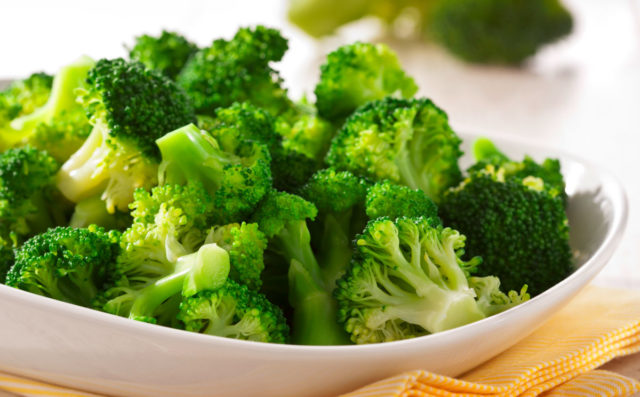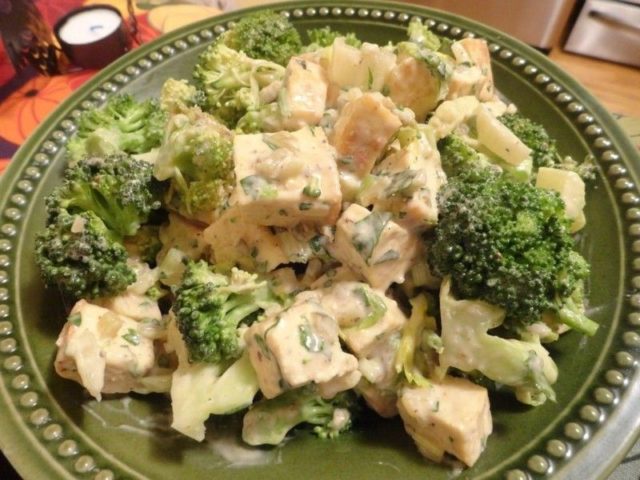Content
- 1 Is it possible to eat broccoli while breastfeeding?
- 2 When can you eat broccoli during breastfeeding?
- 3 The benefits of broccoli for breastfeeding
- 4 Contraindications to broccoli while breastfeeding
- 5 How to cook broccoli while breastfeeding
- 6 Broccoli recipes for breastfeeding
- 7 Useful tips
- 8 Conclusion
Broccoli during breastfeeding is one of the safest and healthiest vegetables. Thanks to the increased content of vitamins, macro- and microelements, asparagus cabbage enriches breast milk and helps the mother heal her body, weakened by childbirth.

Unblown inflorescences with part of the stem are eaten
Is it possible to eat broccoli while breastfeeding?
Breast milk is the best food for a newborn. We must not forget that all dishes from a nursing mother’s diet in an adapted form enter the baby’s body. Therefore, during lactation, a woman needs to carefully adhere to a healthy, balanced diet that will not harm the small child.
Broccoli, unlike other vegetables of the cabbage family, does not cause increased gas formation in the intestines, bloating and colic in mother and baby. The product is hypoallergenic, contains useful vitamins and minerals, and fiber.With proper preparation of dishes, observing the norms of consumption, broccoli can and should be introduced into the diet of a nursing mother during breastfeeding.
When can you eat broccoli during breastfeeding?
Pediatricians advise refraining from eating vegetables immediately after discharge from the hospital. It is recommended to start eating broccoli when the baby is 4-5 weeks old. The first time is to eat 20-30 g of soup and observe the behavior of the newborn for 24 hours. In the absence of intestinal colic and skin rashes, portions of the product can be gradually increased.
The consumption of broccoli during breastfeeding in the second month of the baby’s life can be increased to 100 g. In the future, portions of the vegetable can be 200-300 g up to 3 times a week.
The benefits of broccoli for breastfeeding
The vegetable product extremely rarely causes allergies; it is rich in vitamins A, C, K, folic acid, and beneficial microelements: magnesium, calcium, manganese.
Benefits of broccoli during breastfeeding:
- antioxidants preserve tooth enamel, improve the condition of skin and nails, and prevent hair loss;
- carotene and ascorbic acid restore the body’s immune strength;
- fiber improves intestinal motility, helps with postpartum constipation;
- potassium stabilizes the cardiovascular system, helps get rid of edema;
- magnesium reduces fatigue and copes with irritability;
- the hormone dopamine increases the synthesis of serotonin - helps fight postpartum depression;
- Folic acid is needed for the development of the baby’s bone tissue and reduces the risk of anemia in mother and child.
Contraindications to broccoli while breastfeeding
Very rarely, a newborn develops an allergy in the form of redness on the cheeks and diarrhea. This usually happens if the mother ate broccoli during breastfeeding in the first month of the baby’s life or the norm for vegetable consumption was exceeded. In isolated cases, a baby has a congenital hypersensitivity to vitamin C contained in the product. Negative signs of pathology appear in the form of an itchy rash and persistent diaper rash.
If the baby has a weak intestine, even a small amount of cabbage can lead to bloating and intestinal colic. Undesirable manifestations mean that the child’s body is not yet ready for a change in diet. The next attempt to introduce broccoli into the diet of a breastfeeding mother can be repeated no earlier than a month later.
Women in labor who have undergone a cesarean section are contraindicated in any cabbage dishes for 4-6 weeks. In the future, pureed broccoli may be consumed.
Women with increased blood clotting should use broccoli with caution. The product contains a lot of fiber; stomach ulcers, colitis and other inflammatory diseases of the gastrointestinal tract may be aggravated.
How to cook broccoli while breastfeeding
Nursing mothers can eat asparagus cabbage only after heat treatment: boiled, stewed, baked. The product is most easily absorbed by the body in pureed form. The vegetable goes well with sour cream and vegetable oil.
Eating the inflorescences raw is strictly prohibited - this leads to increased gas formation in mother and baby.Fried and canned broccoli is not suitable for a breastfeeding diet; such food is harmful to the stomach.
The inflorescences must be prepared fresh; the maximum shelf life in the refrigerator is 2 days. The product must not be sealed in trays or plastic bags. Broccoli is thoroughly washed with warm water, removing dirt and putrefactive bacteria.
Broccoli recipes for breastfeeding
Nutrition during breastfeeding should be dietary, without pepper and spices. Short cooking will preserve the maximum of nutrients.
Broccoli omelette

Vegetable dish prepared as an omelette contains protein and fiber
Ingredients:
- broccoli inflorescences - 5-6 pcs.;
- 2 chicken eggs;
- 1.5 tbsp. l. low-fat sour cream;
- 1 tbsp. l. flour.
Preparation procedure:
- Boil the vegetable for 3-5 minutes in water with a little salt.
- Mix eggs with sour cream, beat lightly.
- After combining the ingredients, bake in a pan greased with vegetable oil for 15-20 minutes.
Vegetable omelet is perfect for breakfast for mothers during breastfeeding.
Broccoli soup
Preparing the soup does not take much time. Puréed vegetables are the easiest for the body to digest.
Ingredients:
- asparagus cabbage - 600 g;
- meat or vegetable broth - 1 l;
- onion - 1 pc.;
- cream - 50 g.
Preparation procedure:
- Sauté finely chopped onion for 3-4 minutes.
- Add cabbage inflorescences, cut into 3-4 pieces, simmer over low heat for 3-5 minutes.
- Add vegetables to boiling salted broth and boil cream for 1-2 minutes.
- Using a blender, puree the vegetables until you create a smooth puree.
Puree soup is the first broccoli dish recommended for introduction into the diet of nursing mothers.

Broccoli puree soup is an ideal product for women during lactation
Cabbage Salad
Broccoli in the form of salads is best consumed starting from 2-3 months of breastfeeding.
Ingredients:
- chicken breast - 1 pc.;
- cabbage inflorescences - 5-6 pcs.;
- hard cheese - 200 g;
- sour cream - 100 g.
Preparation procedure:
- Boil skinless breast for 30-40 minutes, cut into cubes.
- Boil broccoli for 5 minutes, cut into 3-4 parts.
- Grate the cheese on a coarse grater.
- Mix the salad with sour cream and salt to taste.
If desired, you can add white bread croutons to the salad.

Chicken breast salad with broccoli - a tasty and healthy dish
Useful tips
When choosing a vegetable to eat, you should pay attention to:
- healthy heads of broccoli are dark green, the presence of yellowed areas and blossoming yellow flowers is unacceptable;
- fresh vegetable - juicy, elastic to the touch, individual branches break off with a characteristic crunch;
- you need to choose groups of inflorescences with soft, thin stems; in overripe cabbage they are coarse.
Depending on the variety, cabbage heads may have a purple or slightly grayish tint.

High quality cabbage always rich in color
In winter and spring, it is better to use a frozen product, which retains up to 70% of the nutrients. Cabbage grown in heated greenhouses in winter contains large amounts of pesticides and nitrates. When choosing to freeze, you need to pay attention to the color of the vegetable (it should be bright green) and the presence of ice. A large amount of ice indicates that the product has been defrosted several times.Violation of storage rules leads to the destruction of most vitamins.
Conclusion
Broccoli dishes during breastfeeding, in the absence of contraindications, are extremely useful for nursing mothers and babies. The mother's body experiences an increased need for vitamins and microelements: calcium, iron, phosphorus. Broccoli is a source of nutrients and fiber; coarse fibers restore intestinal microflora and actively remove toxins, which has a beneficial effect on the quality of breast milk.








